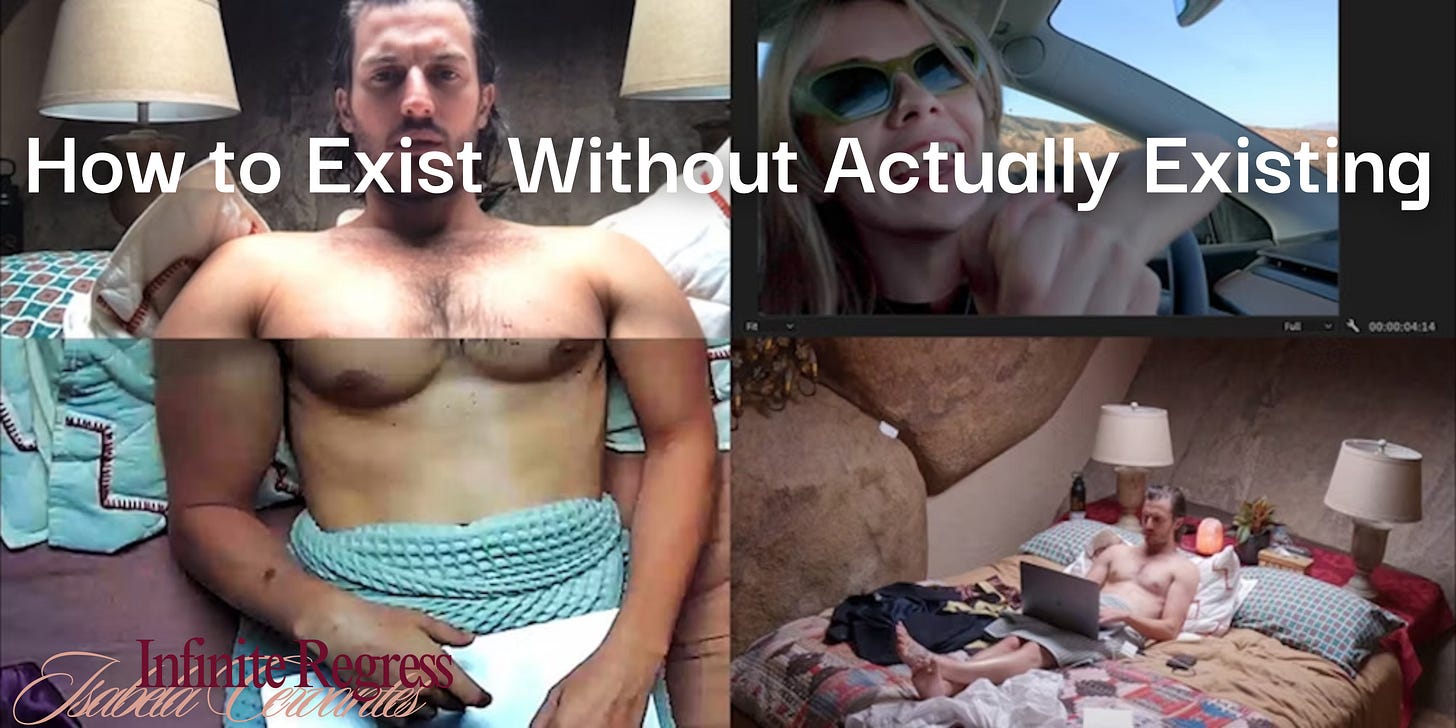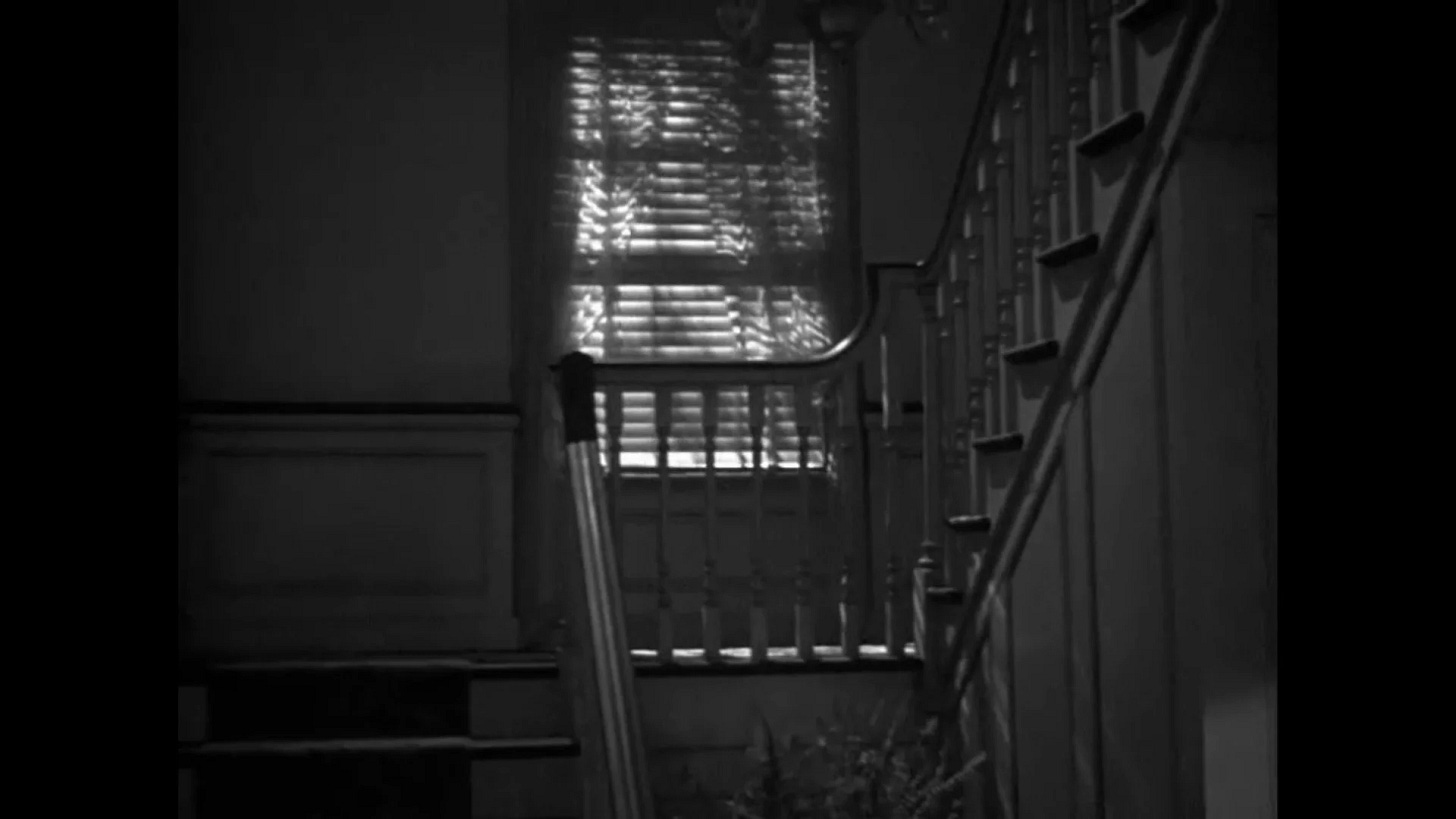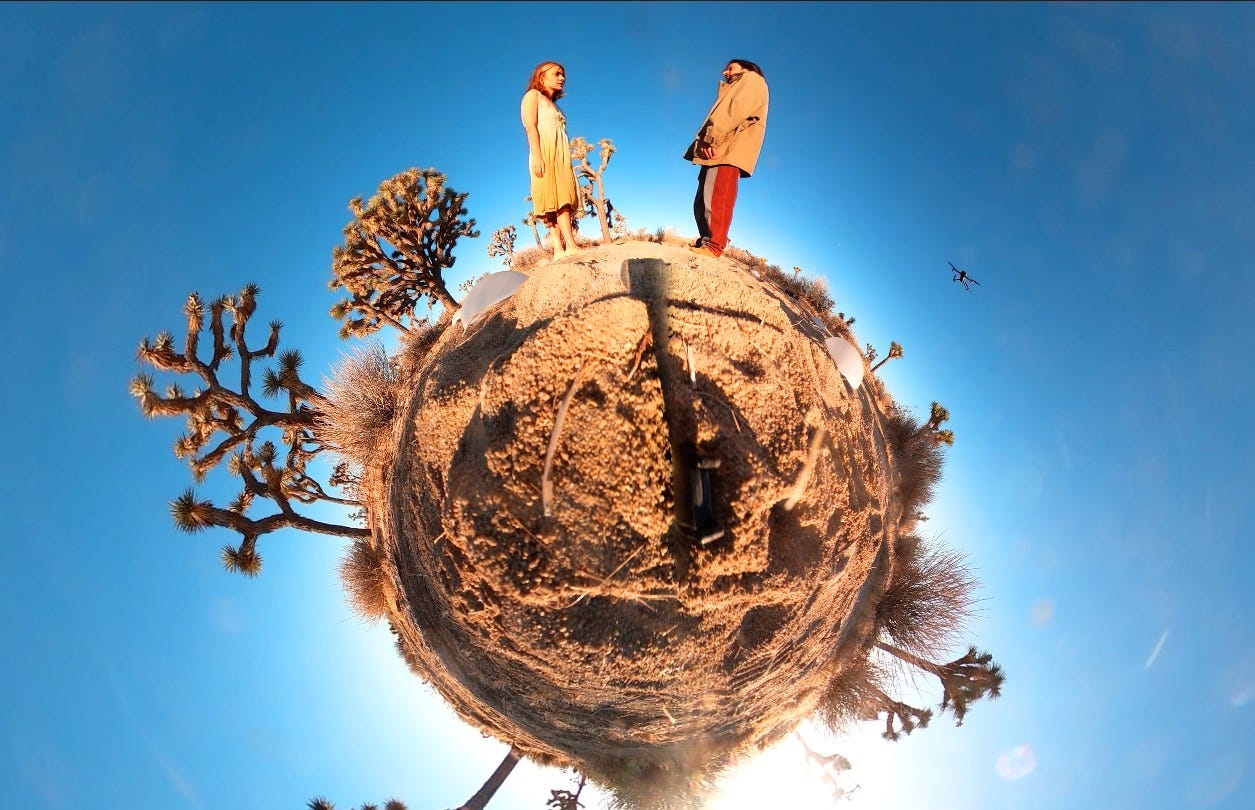How to Exist Without Actually Existing
INFINITE REGRESS is a series of cultural criticism that unfolds over time
This piece extends my exploration of how contemporary culture aestheticizes absence, developed in my essay “It’s Called Mysticism, Sweetie.” Where that essay traced how spirituality is flattened into aestheticized ritual, this piece turns to Eugene Kotlyarenko’s The Code to think about how voyeurism and surveillance become the dominant structures of being, collapsing boundary between spectator and subject.
She is young. My downstairs neighbor with three kids that screech and howl — I am able to identify hers from theirs, deeper and more melancholic. Her children are a mere echo. Sometimes, I watch out the front windows when she receives them on Sunday evenings from a man who drives a black BMW, his blacked-out windows. Once the children are delivered to their mother, the jazz cuts into rap, the bass rattling the Bushwick street as he speeds away. I hide behind the curtains, against the glass, so he can’t see my silhouette. I tell my boyfriend to shut up, so he doesn't blow my cover — I can’t imagine what would happen if they saw me watching.
In the hallway, when I see her locking the door with a cartful of laundry, I say hello in passing. She hardly ever responds. This reserved greeting is always a front — I already know too much about her — the smell of her detergent and how she schedules her vices— the way she smokes pot in the bathroom away from her kids, it comes up to ours through the vents. The nuance of her fried dinners — fish sticks, bacon, anything coated in cornmeal — has risen through the floorboards and stained my shower curtains.
One neighbor, who lost his job last winter, has developed a ritual of departure. He slams and locks his door, steps into the hallway, crouches to lace his shoes, and then re-enters his apartment — again and again, four times exactly. Most mornings now, at 4 AM, he leaves loudly to go mark up the city with the cartoonish tag that I can now recognize on scaffolding and mailboxes. I once caught him crawling up our fire escape; now he discloses his illicit activity while complaining about the super — a petty distraction from his buffoonery.
If the gaze is an inherent perversion, then I have become a pervert since moving into my latest apartment. Not sexually, but spiritually — a titillation born from proximity, the intimate yet separate architecture of city apartment living. Through the peephole — an invention whose very name implies lewdness — I watch my neighbors pass through the narrow stairwell.
✴︎
In Alain Robbe-Grillet’s novel La Jalousie, the act of looking becomes a framework more tangible than any event it records. The narrator — never named or confirmed — watches a woman through the slats of a window blind, through doorways, across dinner tables, every glimpse thick with suspicion and longing. Nothing decisive ever happens. The gaze itself is the only structure: framing her body, fragmenting time, replacing love with the slow violence of interpretation. When I first read La Jalousie, it struck me that voyeurism was a way of organizing reality. To look was already to misrecognize. To watch was already to invent. Intimacy, like violence, was just another function of lack — the need to fill-in what is missing.
Voyeurism folds desire and suspicion into the same gesture. To look is to want — but also to doubt, to control, to fantasize about what remains unseen. According to Merriam-Webster, voyeurism is defined not only as “the practice of obtaining sexual gratification from observing others” but also as “the practice of taking pleasure in observing something private, sordid, or scandalous.” Pleasure, in this sense, is not always erotic. It can be moralistic, punitive, self-soothing — an act that disguises itself as vigilance, even as righteousness.
Freud located the voyeuristic impulse in infantile sexuality — a primal drive to master knowledge of the other’s body, tinged with excitement and guilt. Sartre went further: in Being and Nothingness, he argued that the gaze is not simply an act of seeing, but a rupture — the moment when the subject is seized, exposed, reordered under another’s eye.
To observe, then, is not to record what exists but to distort it — to refashion the world under the pressure of one’s own fear, desire, and doubt. The gaze becomes an act of world-making — and world-weaponizing — where the line between witnessing and violation is never clean. It trembles constantly, vibrating with ambiguity.
In this light, La Jalousie reveals itself as a double entendre: a reference both to the narrator’s vicious longing and to the jalousie window he peers through — a slatted screen that fractures sight into suspicion. Robbe-Grillet’s windows evoke the closet doors in Lynch’s Blue Velvet (1986), where Jeffrey, hidden and paralyzed, witnesses a world he cannot alter. Many filmmakers have grappled with this tension: the camera does not simply record but distorts, eroticizes, violates — a liability built into the human eye.
For filmmakers, this has always been a structural problem. Seeing is never neutral. Cinema has long risked turning what is most inward — love, grief, desire — into spectacle. In Contempt (1963), Godard shows how tenderness disintegrates under the cold demands of cinematic vision: how lovers begin to see themselves through the eyes of imagined audiences, until their gestures harden into performance. Love becomes another transaction staged for someone else’s consumption.
✴︎
The anxieties of Contempt’s world have congealed around us. Every glance calcifies into data; intimacy is no longer sheltered — it is soldered by surveillance itself. We do not vanish under the gaze; we are organized by it.
Eugene Kotlyarenko’s The Code (2025) pushes this collapse to its natural end. Here, romance isn’t contaminated by the gaze — it is built entirely through it. Jay (Peter Vack) and Celine (Dasha Nekrasova) cannot exist together without being watched. Supervision becomes the only intimacy left: they love each other through the cameras.
The Code maps a world where surveillance is not the dark side of closeness but its scaffolding. Jay and Celine — sexless, paranoid, suspended between performance and longing — stage and restage themselves under each other’s gaze, filming and being filmed, fracturing connection into endless, anxious images.
The claustrophobia of The Code sharpens through its casting. The faces are recognizable, but not famous: Nekrasova, Vack, Ivy Wolk, Casey Frey — figures who orbit the internet’s compulsive feedback loops, celebrities of a world we can only participate in abstractly. Their presence activates a sideways, compulsive voyeurism: the social-media gaze, where familiarity sharpens estrangement and substitutes for real kinship.
We don’t just watch them perform; we watch them perform versions of themselves. Their performances are calibrated to an audience they anticipate and seduce — us. In Being and Nothingness, Sartre writes that to be seen by another is to suffer a break: “I see myself because somebody sees me.” Under the gaze, the subject freezes, becomes an object, experiences shame.
But The Code twists this dynamic. Here, it is the audience who freezes. Watching actors already performing their own spectatorship, we find ourselves fixed, implicated. The Code becomes a screen through which the audience recognizes its own helpless visibility.
Maybe that’s its deeper seduction. Voyeurism doesn’t just seek an object — it seeks its own reflection. The act of looking isn’t complete until it is returned. Only then does the watcher feel, perversely, real. It’s strange how easily the reversal between subject and object can take hold.
At the start of The Code, Jay and Celine flee the early days of the pandemic in a borrowed Tesla, heading for the California desert under the flimsy pretext of making a documentary. The escape fails immediately. Instead of collaboration, the camera becomes a weapon: Celine films Jay, Jay films Celine, both film themselves, each glance hardening into suspicion, each silence bracing for accusation. Surveillance migrates with them, embedding itself deeper inside the house, until what begins as a documentary dissolves into a cold war of hidden cameras — love recast as paranoia.
✴︎
Kotlyarenko had sent me The Code in an expiring Instagram link a month before its NYC premiere at Roxy Cinema. Watching at home should have offered distance — the comfort of fiction, the reassurance that the looking was one-sided. Instead, the film folded into my life, until watching felt exposed, reciprocal.
I could pause the movie, slip to the back door when a disturbance rattled the hallway, and peer through the peephole — the corridor compressed into a trembling fisheye.
Onscreen, Celine and Jay circled each other with their cameras; in the hallway, my neighbors slammed doors and shouted, earthquaking the building. The surfaces thinned. The Code pulsed on my laptop, waiting to resume, as I watched our super locked in a incriminating confrontation with the jobless tagger. Their voices cracked against the drywall, sharp and humiliating. I stood there, hidden, breath held — not from fear exactly, but from the deeper feeling that I was part of it. That witnessing wasn’t passive. That every act of looking stitched me deeper into the scene.
When I returned to the film, it no longer felt like a story unfolding, but as if the hallway itself had leaked into the frame — accusation, exposure, the slow corrosion of being seen too long. Jacques Rancière writes in The Emancipated Spectator: “Looking is not a passive activity. It is an act that confirms or modifies the distribution of capacities and incapacities.” There is no safe distance. The voyeur is never innocent. To witness is to intervene, to tip the balance of what can happen.
The unstable relation between observation and existence — public and private — has long preoccupied Kotlyarenko. In earlier films like Wobble Palace (2018) and Spree (2020), he traced how social media, consumer performance, and self-invention bleed into one another, how the line between sincerity and theater is eternally unstable. But The Code feels different. Bleaker. More recursive. It no longer satirizes surveillance from the outside — it confesses to being trapped inside it, circling through images with no way out but to keep recording.
Watching The Code alone in my apartment, I felt this pressure. The creaking foundation, the hissing vents, the slammed doors — none of it clarified anything. I wasn’t documenting events. I was hoarding fragments, mistaking absences for evidence. Watching didn’t reveal the world; it fractured it, scattering it into endless uncertainties.
Kotlyarenko understands this perfectly: Surveillance doesn’t simply rupture reality — it trains us to crave the rupture. Jay and Celine don’t resist the collapse of their own self-documentation. They plunge deeper, filming not to preserve intimacy, but to replace it. Without the camera, there would be no proof that anything between them ever existed — no cruelty, no yearning, no shame to sanctify.
And observing them, I felt the same gravitational pull: the impulse not to look away, but to gather more. The only way to survive surveillance is to accelerate it — until nothing is left but the record of having been watched.
✴︎
This is where The Code stops pretending to diagnose and starts to implicate. Kotlyarenko doesn’t just stage the sickness of self-scrutiny — he weaponizes it against the audience. Every sidelong glance from Celine, every wounded smirk from Jay, every pixelated frame of their painful engagement flatters the very voyeurism the film pretends to expose.
It’s no accident that the film spirals into ritual. Ivy’s sudden wedding to the landlord — a frantic ceremony between strangers — doesn’t feel like narrative resolution. It feels like a nervous tic. A desperate attempt to pretend that connection, meaning, or continuity still exist in a landscape already reduced to pure image.
In La Jalousie, Robbe-Grillet showed how repetition — looking, glimpsing, doubting — does not stabilize intimacy. It hollows it out. The gaze, meant to capture meaning, only multiplies its absence. The Code inherits this logic. Jay and Celine’s scavenger hunt, Ivy’s wedding — these are not acts of hope. They are the frantic reenactments of structures that have already flattened. They perform love, loyalty, community — not to preserve them, but to cover over their disappearance.
After orchestrating a final humiliation, Celine disappears, leaving Jay to scavenge through the wreckage. What begins as a search for reconciliation quickly devolves into a scavenger hunt through Jay’s own memories — the scenes we have already witnessed, now emptied of urgency, nullified by recurrence. Each location, once charged with longing or betrayal, becomes just another stop in a rigged game, another image in a hall of mirrors. Jay’s pursuit isn’t driven by hope. It’s driven by inertia, as if by walking the same routes, he could summon back the love that once animated them.
The scavenger hunt becomes a parody of closeness, just as the wedding becomes a parody of renewal. These rituals don’t reconstruct what has been lost. They only aestheticize the loss itself — staging devastation as if it could still mean something. When Jay finally finds Celine, stranded in the desert at sunset, they consummate their relationship — an act framed not as communion, but as the last exhausted rite left to them. Even this fails to restore anything.
The final sequence folds the film back onto itself: Jay and Celine — or facsimiles of them — sit in a sterile studio, analyzing the footage we have just witnessed. Their identities blur into the machinery of their own documentation. It no longer matters whether they are the same people, actors playing roles, or simulations generated by endless repetition. The final revelation is not reunion but recursion: memory is a screen. Watchers watching watchers.
The roots of voyeurism aren’t so deviant. They grow out of a basic, undiscriminating visual curiosity. Wonder isn’t neat or goal-oriented; it’s amorphous, restless, directed at anything and everything: the seen and unseen, the real and imagined, the obvious and obscure.
Sight, among the senses, holds a privileged position. It insists on crossing boundaries, ignoring what’s supposed to stay hidden. Seeing disregards frontiers as a matter of principle. The more rules we invent to govern what should remain invisible — what shouldn’t be touched, what shouldn’t be witnessed — the more inevitable it becomes that we crash against them.
I have always been curious about others — reading a hookup’s diary when he left the apartment, rifling through cupboards and drawers at an Airbnb, finding the secret BDSM paraphernalia of the parents whose children I nannied one summer — I joke not. Is this a perversion or a will — a desire not just to observe, but to enter? To inhabit someone else’s life without permission, to feel the heat of their privacy without announcing my presence? Is this inherently sexual?
Watching The Code, these questions and distinctions feel essentially meaningless. The act remains the same: intrusion disguised as inquiry.
But maybe even calling it voyeurism is a categorical error. When exposure is constant and expected, the act of looking no longer crosses any frontier. It simply repeats the conditions already in place. Here, watching no longer violates privacy — it abolishes it. The gaze circulates ambiently, compulsorily, repeating itself across a world where nothing is hidden, or whole.
I have searched all my neighbors on Google, starting with the names scrawled on their mailboxes. I have found their social media profiles, traced their extended families, watched them give birth to children and pray for dying mothers. I hear refrigerators open. Water run. Never laughter — only the occasional whine, like a prayer.
All winter, I swear they never left their apartments. Now that it’s spring, they’ve started to surface on the sidewalks; maybe by summer they will have made it to the park. When I see them, I always recognize them, and they look at me with an absent glare, if at all.
The absence of their validation, like a heavy gust of wind, will pass through me — cleansing my soul — reminding me that to most people, I hardly exist at all.
It is only under the speculation of my own controlling gaze that I bring myself to life.
~







i loved reading this! circled back to bystander effect rabbit hole while reading